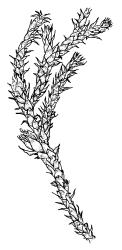Plants medium-sized, hoary, grey-green above, often dark brown or nearly black in lower portions, lacking stolons; forming loose mats on dry rock. Protonema globular, irregular in shape, mainly composed of rounded cells (fide de Luna 1990). Stems curving away from the substrate, branching irregularly, in cross-section with incrassate outer cells grading into parenchymatous medullary cells, lacking a central-strand. Rhizoids sparse, scattered on stems, smooth, brown. Shoots appearing hoary due to widely spreading white hair-points when dry, not julaceous. Leaves appressed in their lower portions, erect, erect-spreading, or widely spreading when dry, spreading when moist, oblong-ovate or broadly ovate, acuminate or acute at apices, with short or elongate and white hair-points, weakly decurrent, concave and appearing smooth abaxially under a hand-lens, entire (except the hair-point), plane at margins or reflexed below; upper laminal cells irregularly subquadrate to rectangular, with very incrassate and sinuose walls, the adaxial surface with 1 to several conspicuous and simple, branched, stellate or peltate papillae, the abaxial surface less papillose, the laminal cells becoming longer and with more papillae in lower third of leaf; cells of the hair-point strongly differentiated or rarely not present, linear-fusiform, colourless, with thick and undulate walls and numerous non-stellate papillae, the terminal cell less papillose to ± smooth and either acute or truncate/papillose apically; central cells of leaf base more or less linear, non-papillose, porose, forming a large and conspicuous gold-brown group; marginal cells at base short and ± quadrate in several rows; costa absent.
Autoicous. Perichaetia terminal on short branches, the inner leaves oblong-elliptic, ciliate or entire at margins. Perigonia gemmiform, scattered on stems, with bracts ovate, strongly pigmented, concave, and entire, surrounding numerous antheridia and filiform paraphyses. Setae very short and straight; capsules immersed, erect and symmetric, hemispheric when young, becoming cupulate after dehiscence, lacking a differentiated neck, smooth, gymnostomous, narrowed slightly at the transverse mouth; exothecial cells mostly oblong, rather thin-walled, not in alternating bands, with several rows isodiametric, thicker-walled, and more pigmented at mouth; annulus lacking; operculum umbonate. Calyptra mitrate. Spores reniform, coarsely lirate-murate, often with a faint proximal trilete scar.
Hedwigia has traditionally (Brotherus 1925) been treated to include a single species of nearly cosmopolitan distribution. Some authors (e.g., Sainsbury 1955; Smith 2004) have also included Hedwigidium integrifolium in Hedwigia, but this has received limited acceptance. Hedwigidium is maintained as a separate genus here.
Recent northern hemisphere studies (Hedenäs 1994; Buck & Norris 1996) have recognised additional taxa in Hedwigia and advocated an emended and narrower concept of H. ciliata. Buck & Norris (1996) recognised three species, including the recently described H. stellata Hedenäs, from the west coast of North America. In their discussion they stated that an additional species, which they tentatively named H. nivalis (Müll.Hal.) Mitt., occurs from Arizona south to Argentina. They also speculated that this species might occur in Africa and Australasia.
| Category | Number |
|---|---|
| Indigenous (Non-endemic) | 1 |
| Total | 1 |




